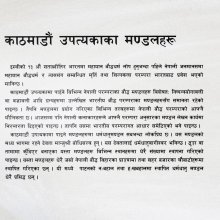Aum, Āuṃ: 4 definitions
Introduction:
Aum means something in Hinduism, Sanskrit. If you want to know the exact meaning, history, etymology or English translation of this term then check out the descriptions on this page. Add your comment or reference to a book if you want to contribute to this summary article.
Images (photo gallery)
Languages of India and abroad
Sanskrit dictionary
Source: DDSA: The practical Sanskrit-English dictionaryAum (औम्).—ind. The sacred syllable of the Śūdras (for om which is forbidden to be uttered by them).
Source: Cologne Digital Sanskrit Dictionaries: Monier-Williams Sanskrit-English DictionaryAum (औम्):—ind. the sacred syllable of the Śūdras (See 3. au).
[Sanskrit to German]
Sanskrit, also spelled संस्कृतम् (saṃskṛtam), is an ancient language of India commonly seen as the grandmother of the Indo-European language family (even English!). Closely allied with Prakrit and Pali, Sanskrit is more exhaustive in both grammar and terms and has the most extensive collection of literature in the world, greatly surpassing its sister-languages Greek and Latin.
See also (Relevant definitions)
Starts with (+30): Auma, Aumaka, Aumapata, Aumara, Aumbalia, Aumbheyaka, Aumca, Aumcana, Aumcana, Aumcia, Aumcu, Aumda, Aumdha, Aumdhana, Aumdhi, Aumdo, Aumdu, Aumeyi, Aumika, Aumina.
Ends with (+187): Abu-an-naum, Aghaum, Ahua baum, Ana baum, Anekaum, Anthanabbeaum, Anthanabbeyaum, Anthaunnaum, Arabaum, Asiaum, Athacalisaum, Athahattaraum, Atharaum, Athasatthiaum, Athasatthiyaum, Athatisaum, Athaum, Atthaisaum, Bahattaraum, Bahraum.
Full-text: Shankha, Om, Ksham, Mandukya, Yajnopavita, Parashakti, Homa, Ajna, Agneyi, Mandukyopanishad, Akshara, Vishuddha.
Relevant text
Search found 36 books and stories containing Aum, Āuṃ; (plurals include: Aums, Āuṃs). You can also click to the full overview containing English textual excerpts. Below are direct links for the most relevant articles:
Mandukya Upanishad (Gaudapa Karika and Shankara Bhashya) (by Swami Nikhilananda)
Mandukya Karika, verse 1.25 < [Chapter I - Agama Prakarana (Scripture)]
Mandukya Karika, verse 1.27 < [Chapter I - Agama Prakarana (Scripture)]
Mandukya Upanishad, verse 2 < [Chapter I - Agama Prakarana (Scripture)]
Shaiva Upanishads (A Critical Study) (by Arpita Chakraborty)
13. Chāndogya Upaniṣad and Udgītopāsana on ‘OM’ (Aum) < [Chapter 2 - “Om” and its Esoteric Significance]
11. The Taittirīya Upaniṣad glorifies on “OM” < [Chapter 2 - “Om” and its Esoteric Significance]
12. Māṇḍūkya Upaniṣad on ‘OM’ (Aum) < [Chapter 2 - “Om” and its Esoteric Significance]
Consciousness in Gaudapada’s Mandukya-karika (by V. Sujata Raju)
The equation of the states with the syllable Aum < [Chapter 3: A Study of Māṇḍūkya Kārikā: Āgama Prakaraṇa]
Three states of Consciousness: wakeful, dream and deep sleep < [Chapter 3: A Study of Māṇḍūkya Kārikā: Āgama Prakaraṇa]
Vedic influence on the Sun-worship in the Puranas (by Goswami Mitali)
Part 7 - Sūrya (the Supreme Reality) < [Chapter 2 - Salient Traits of the Solar Divinities in the Veda]
Sun-worship Vratas (3) Arkasampuṭa-saptamī < [Chapter 5 - Rituals Related to the Sun-Worship in the Purāṇas]
Sun-worship Vratas (33) Marīca-saptamī < [Chapter 5 - Rituals Related to the Sun-Worship in the Purāṇas]
Mandukya Upanishad (by Kenneth Jaques)

